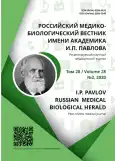在严重下肢缺血情况下采用人工假体复腘胫骨段效果的改善
- 作者: Matyushkin A.A.1,2, Lobachev A.A.3
-
隶属关系:
- Russian National Research Medical University named after N. I. Pirogov
- City Clinical Hospital named after D.D. Pletnev
- City Clinical Hospital named after the Bakhrushin brothers
- 期: 卷 28, 编号 2 (2020)
- 页面: 200-212
- 栏目: Original study
- ##submission.dateSubmitted##: 02.07.2020
- ##submission.datePublished##: 03.07.2020
- URL: https://journals.eco-vector.com/pavlovj/article/view/34908
- DOI: https://doi.org/10.23888/PAVLOVJ2020282200-212
- ID: 34908
如何引用文章
详细
目的:目的分析人工假体在严重下肢缺血患者行股骨远端腘窝及胫骨旁路手术的近期及远期效果。
材料与方法:在2009-2017年期间,下肢慢性动脉供血不足严重危重阶段109例在D.D.Pletnev City Clinical Hospita国家预算机构的莫斯科大学外科诊所接受了手术。他们进行了股骨远端腘动脉旁路移植术或股骨胫骨旁路移植术,使用人工植体的聚四氟乙烯(PTFE)。33例(30.3%)患者搭桥手术是用人造假体进行的,76例(69.7%)采用外植体结合自体静脉,44例(40,4%)采用人工假体+自体静脉,32例(29.3%)采用根据补片或袖口类型进行远侧吻合口。两组患者中有14例(12.8%)在干预过程中辅以术中小腿动脉球囊血管成形术。对手术后5年的长期结果进行评估。Kaplan-Meyer生存分析用于计算结果。
结果:人工假体5年累计通行性为42.9%。然而,使用假体联合自体静脉,其采用联合分流或远侧吻合口,可显著提高累计通行性(54.5%),以及保肢功能(83.6%)。
结论。所获得的结果允许推荐在没有完全自体静脉发生的情况下,使用人工假体联合远侧吻合口的自体静脉成形术,或者把假体和小的自体静脉结合起来。为了改善长期效果,有必要对此类分流进行长期定期监测,并及时实施反复干预。
全文:
闭塞动脉粥样硬化与腹股沟下段动脉闭塞狭窄病变是截肢的常见原因[1]。近几十年来,现代血管外科手术,包括外周动脉外科手术,已经获得了全新的诊断和治疗方法,使残疾和死亡率大大降低。其中新的以及最重要的是血管内治疗,尤其在股骨腘窝和胫骨的疾病情况下[2]。
然而,严重下肢缺血的问题仍然很重要,需要寻找能够直接重建下肢动脉血管的方法。根据TASCII,C型和D型腹股沟下病变(延伸超过15厘米,股浅动脉狭窄或闭塞,涉及腘动脉,小腿动脉严重受损)最常导致严重缺血。同时,使用血管内的治疗方法是可能的,但优先考虑《开放式》手术。对于这类严重缺血患者,通常会进行股骨远端腘窝或股骨胫骨旁路手术。
在移植物功能期间,自体静脉超过任何物质[3]。然而,在反复重建、静脉曲张扩张、主动脉冠状动脉搭桥(ACBS)的静脉取样等过程中,常出现其缺失的情况。在这种情况下,强制使用人工假体导致的长期结果可与自体静脉相比,只有当远侧吻合口应用于膝关节间隙以上[4]。在股腘动脉旁路手术中使用人工假体,在假体通畅性和保肢方面都存在干预结果显著恶化的风险[5]。
对于没有足够的自体静脉(主动脉冠状动脉搭桥取自体静脉、下肢静脉曲张、反复重建)的严重缺血患者,寻找提高人工假体使用效果的方法,是目前外周血管手术中尚未解决的主要问题之一。
近年来,我们诊所引进了一种比较新的手术方法—《混合手术》。混合手术认为是重建动脉手术,在《混合》手术室进行血管内阶段。这种治疗方法对多层病变是有效的,在保证分流管充分操作时,需要对流入或流出通道进行一期矫正。在本研究中,我们在一些病例中进行了股骨远端腘窝或股骨胫骨旁路手术,同时进行了胫骨或髂段血管成形术。
因此,本研究的目的是评估采用人工假体作为移植物在术后早期和长期手术治疗股骨腘段和胫骨段动脉粥样硬化病变患者的效果。
材料与方法
在2009-2017年期间,109例下肢动脉粥样硬化严重缺血期患者在国家预算制度莫斯科D.D.Pletnev City Clinical Hospital的大学的外科诊所接受手术。所有患者股浅动脉闭塞合并腘动脉损伤,多合并下肢动脉损伤。所有病例均采用人工聚四氟乙烯(PTFE)假体作为分流材料。无法使用自体静脉的主要原因为:18例(16.5%)以前各种动脉重建的静脉取样,79例(72.5%)大隐静脉小直径(小于3mm)结构疏松型,既往静脉切除术—12例(11.0%)。
将患者分为两个对照组。第一组包括33例(30.3%)。他们使用人工假体进行了股骨远侧腘窝或股骨胫骨旁路手术。第二组包括76例(69 7%),其人造假肢是辅以成形术的远侧吻合口自体静脉袖口或补丁(Miller袖口、Linton补片、Nevil补丁)或在远端部分重建用一块自体静脉的结合(自体静脉段的平均长度为7厘米)。
在远侧吻合口术中,以《Linton补片》型最为常见。该方法分为以下几个阶段:首先,行4厘米长的腘动脉纵向切开术。然后取一小段(3-4厘米)自体静脉。将静脉纵向切开,以导管的形式连续缝合置于动脉内,然后进行长达2厘米的静脉切开术(补片手术)。然后形成带假体的远侧吻合口(图1)。
图 1。Linton补片类型的远侧吻合口形成阶段: A—使用自体静脉插入物进行整形手术插入物;B—进行补片手术;C—吻合在人工假体与补片的位置;D—吻合的完成
两组主要统计指标具有可比性。患者的平均年龄为71±2岁,年龄从53岁到74岁不等。糖尿病是最占首位的共病合并症—50例(45.9%)。
两组均采用常规的下肢动脉粥样硬化闭塞患者的检查和治疗方法。仪器检查的主要方法是超声多普勒显像(USDG)与踝肱指数逐层测定(ABI)、血管造影。
本研究纳入的所有患者,病变类型均按照TASC分型进行评估[3]。根据TASCII分型,79人(72.5%)登记为C型病灶,30人(27.5%)登记为D型病灶。不同病变类型(C、D)组的临床和人口学参数无差异。
在所有情况下,都考虑了Rutherford在1997年提出的外围阻力评分。这使能够评估下肢动脉咬合狭窄损伤的程度及其对分流的意义,计算外周阻力评分,从而客观地评价该指标。在人工假体单独使用组中,得到的数据如下:8例(24.2%)患者外周阻力最低为1分;21个例(63.6%)—从2到8分,4例(12.1%)—从8到10分。不同类型吻合整形及联合分流组(II组)中有7例(9.2%)患者有1个阻力分;59例(77.6%)—从2到8分,10例(13.1%)从8到10分。
在14例(12.8%)多层病变的病例中,特别是当下肢动脉的外周阻力指数为>8,我们进行了混合干预。实施干预的一个重要因素是技术能力—合适的导线、球囊导管和混合手术室的可用性。我们组典型的混合手术场景是:在混合手术室中,采用塑性远侧吻合口或联合分流技术行股骨腘远端或股骨胫骨旁路手术。然后进行术中血管造影,必要时用分流或补片导管穿刺远侧床矫正,小腿动脉的血管成形术是在《主》血流量开启时进行的。
结果与讨论
在第一组患者中的33例患者中,只有25(75.7%)在第一个月维持了重建的通行性。在17例(51.5%)患者中,临床状态相当于+3,在7例(21.2%)中当于+2,在9例(27.3%)中当于+1。45例(77.5%)患者术后早期重建维持了其通行性。
在1到10天期间,13例患者诊断为分流血栓。7例患者经血栓切除及反复重建回复了分流的通行性。1例血栓形成的原因是通道内分流器的扭曲,其他患者的外周阻力高(根据卢瑟福量表为8—12分)。2例患者的外周抵抗在8分进行评估,8例患者在10分。主动脉血流量恢复的7例患者中,只有1例维持了良性动态。另一名患者需要在髋部截肢。
术后并发症:6例出现淋巴溢(12.0%)。1例(2.0%)有伤口浅表感染。8例(13.7%)伤口出血。9例(5.2%)患者有伤口表面舒张。1例(2.0%)有深部创面舒张。
系统性疾病发生于1例(2.0%)患者—急性心肌梗死。1例(2.0%)出现下叶肺炎。没有人死亡。
第二组术后早期的结果如下:76例患者中64例(84.2%)在术后1个月内保持了分流的通行性。32例(50.0%)患者临床状态改善+3。25例(39.1%)为+2。而7例(10.9%)适合+1。
在1— 6天内观察到10例(13.1%)分流血栓的形成。所有患者均再次进行分流血栓切除术,或者反复重建的血栓切除术。6例患者在14天内出现明显的再次分流血栓。旁路血栓形成的原因是高外周阻力(根据卢瑟福量表为8—12分)。在所有患者中,不需要肢体截肢。术后早期保肢指数为100%。
术后并发症见表1。术后早期无死亡病例。
表1
两组患者术后早期的并发症
并发症 | 第一组 | 第二组 |
n | 33 | 76 |
分流血栓形成,n (%) | 13 (39.4%) | 10 (13.2%) |
淋巴溢,n (%) | 6 (18.2%) | 2 (2.6%) |
伤口感染,n (%) | 1 (3.0%) | 2 (2.6%) |
伤口流血,n (%) | 8 (24.2%) | 5 (6.6%) |
伤口舒张,n (%) | 9 (27.3%) | 10 (13.2%) |
心脏病发作,n (%) | 1 (3.0%) | 0 (0%) |
慢性支气管炎的恶化,n (%) | 0 (0%) | 1 (1.3%) |
因此,在术后早期,第一组的分流血栓发生率最高(表1)。在使用人工假体而不使用自体静脉段的组中,术后出血和浅表舒张是常见的。
在第一组血栓形成病例中(n=13),有8例分流血栓形成伴血流动力学障碍及手术失误的患者行血栓切除术有效。另外5例由于下肢动脉损伤严重,并外周阻力大,重复手术均未见效果。一名病人由于坏死性改变的进展需要在髋关节水平截肢。在第二组中,血栓切除术在10例分流血栓形成的7例中有效。分流血栓形成的原因是相似的。
在第一组中,分流在术后早期(长达1个月)的累积通行性为60.6%,在第二为86.9%。
分析两组长期结果发现,第一组和第二组的分流血栓主要发生在观察的前12个月。第一组患者中有19例(57.6%)患者发生分流血栓。其中14例尝试分流血栓切除术,其中一半(n=7)血栓切除术成功,并进行了三次重复重建手术。在分流血栓形成和无效血栓切除术的背景下,进行了4例截肢手术。3例分流血栓切除术患者在手术中辅以远侧吻合口及小腿动脉球囊成形术,使5个分流全部恢复功能,最小随访时间为1年。
在长达1年的随访中,我们根据反复手术和肢体切片的结果,14例患者中有8例发现远侧吻合口严重狭窄,其是重建血栓形成的原因。
经过2年的随访,只有一个新的可通分流血栓形成。这个病人成功地接受了再次手术。在此期间,对另一名较早接受手术的患者进行了原发性截肢。在第一组中,观察第二年保肢率为63.4%。
3年后,仍有40例患者接受观察。1名患者死亡,3名因各种原因退出。由于没有急性缺血或严重缺血,记录了一例分流血栓形成,没有重复干预。该组3年内累积通行性为50.0%。保肢率为62.5%(p<0.05)。
5年后,35例患者继续接受观察,3例死亡,2例退出观察组。从第3年至第5年,仅观察到了2例旁路血栓形成。其原因是动脉粥样硬化在流出和流入通道的进展。累积通行性为42.9%。在长达5年的时间里,总共进行了16次截肢,第一组患者的保肢率为54.3%。
第一组人工分流的累积通行性为48.5%。因此,分流血栓形成和截肢主要发生在术后第一年。
在第二组使用人工合成假体和自体静脉的患者中,观察了在长达一年的时间内分流血栓形成的主要数量。经过1年62例患者的观察,获得了如下结果。在整个观察期间,观察到了17例(22.4%)分流血栓形成。分流道血栓形成的主要原因是流出道内动脉粥样硬化的进展。17名患者中有15人成功地进行了重复干预。两例患者在手术中采用了血栓切除术联合小腿动脉球囊成形术。观察第一年的累计通行性为77.4%。在8例患者中,由于缺乏满意的流出路径,在没有尝试血管重建的情况下进行了下肢截肢。观察1年后保肢率为87.1% (p<0.05)。
经过2年的观察,对62例患者的治疗结果进行了评估。有4例(6.4%)新的旁路血栓形成。其中两例接受了成功地重新手术干涉。另外两个接受了肢体截肢。
3年后,仍有60例患者接受观察。记录3例分流血栓形成,未重复手术干预。在没有急性或严重缺血的情况下。该组1年内累积通行性为68.3%。保肢率为85.0%。
经过5年的观察,55人(72.4%)仍在观察中。在观察5年内,共观察到了25例分流血栓的形成。其主要原因是动脉粥样硬化在流出或流入通道的进展。累积通行性为58.2%。在长达5年的时间里,总共进行了9次截肢手术。第一组患者保肢率为83.6%(p<0.05)。
两组患者的累计通行性和保肢力见图2和图3。
图 2。在60个月的观察中,研究组的人工假体的累积通行性
图 3。在60个月的观察中,研究组的肢体保存
使用自体静脉整形手术远侧吻合口的可能性时,强制使用人工假体在一个严重缺血的病人可以清楚地说明以下临床例子。
M.病人, 70岁,2012年11月在国家预算制度莫斯科的 D.D. Pletnev City Clinical Hospital接受了手术。为小腿肌肉的间歇性跛行的疼痛所困扰。无痛行走的距离在短时间内缩短到30米。平静状态下出现疼痛的感觉。在病史中记录了滥用吸烟的信息。入院时对下肢进行例超声多普勒成像检查,为了测量踝肱指数(0.32)。
图 4。M.患者,70岁,左脚微循环失调,在水平位置上以皮肤明显苍白的形式出现
主动脉造影显示腹股沟下段动脉粥样硬化性改变。股总动脉不明显狭窄达30%,可见股浅动脉口至腘动脉闭塞,腘动脉闭塞,腘动脉第二段严重狭窄。显示了明显(60%)胫骨后动脉狭窄。
小腿动脉狭窄。保留了足底动脉弓(图5)。
图5。70岁M.病人的血管造影片:A—主动脉髂节,血流动力学无明显狭窄;B—股浅动脉闭塞(箭头所示);C—腘动脉血流动力学明显狭窄(箭头所指);D—下肢动脉(箭头所示),远端外周阻力估计为3点
双工扫描证实了下肢动脉的主要闭塞狭窄病变,并在旁路手术中发现双下肢大隐静脉和小隐静脉不适合移植。双大腿上三分之一处大隐静脉直径2.5毫米,可见疏松型结构,小隐静脉直径为<2.5毫米。
由于缺乏一个满意的直径的自体静脉作为分流,决定进行一个普通的股骨腘动脉分流与人工假体通过修补使用Nevil方法。
行长度为3.5厘米的动脉切开术,随后行修补型自体静脉切开术,增加动脉直径,减少假体与动脉之间的组织错配(图6)。
图6。70岁M.病人的手术干预阶段:A—大面积动脉切开术的补片形成;B—补片和人工假体之间进行端到侧的吻合
下一阶段是近端2/3补丁的修补,以创建一个《袖口》形状。在吻合内形成血液湍流的区域。这加快了吻合点区域的血流速度,其减缓了新生内膜增生的过程。然后在自静脉补片和端到侧人工假体之间进行吻合。在远侧吻合口形成后,将假体插入近端创面。吻合按端到端型在人工假体与股动脉之间进行的。在开始血流后,足部动脉的脉动开始检测出来。
术后早期无出现局部或全身并发症。伤口因初期愈合而痊愈。严重缺血在术后早期消退。病人在医院咨询和诊断科的门诊进行观察。患者按照建议及方案进行双分类治疗:氯吡格雷75毫克一天1次+乙酰水杨酸75毫克一天1次。
手术一年后,病人住院时经主动脉造影诊断吻合远端的腘动脉狭窄(70%)。临床表现为无痛行走距离缩短至150米,足背搏动减弱。病人接受了腘窝区气囊血管成形术,有很好的血管造影结果。200多米的无痛步行距离已经恢复。6个月后进行双功彩色超声诊断仪,无明显狭窄。
这个临床案例说明了在没有合适的外科手术自体静脉的情况下的外科技术。这反映了重建区定期门诊监测和流出动脉的需要性。
因此,如果需要使用人工假体进行股骨腘窝、股骨胫骨旁路手术,建议进行自体静脉远侧吻合口或联合分流术。 该方法可显著提高人工假体的长期开放效果。根据我们的数据,这些技术的积极影响范围是在6个月到1年的观察期间,第一组患者出现血栓形成,其中一部分是由于远侧吻合口肌内膜增生而形成。
众所周知,在直接血运重建过程中,内皮细胞总是会受到损害。这是因为施行动脉切开术合并吻合是不可避免的。内皮似乎通过内膜的增殖来减少间质冲突。吻合的管腔不可避免地发生改变,从而重新调节动脉管腔内的血流[6, 7]。
由于动脉和假体之间的组织差异显著,动脉壁的上皮化仍然不完全。因此,吻合新生内膜增厚最明显的部位主要是人工假体与动脉之间的吻合,而不是动脉与自体静脉之间[8]。
在术后早期,自体静脉功能和人工假体的持续时间无显著差异。显然,这是由于分流血栓形成的原因是手术的技术错误。这些通常包括改变分流的几何形状、压迫假体、扭转内膜以及不正确的手术策略[9]。
在6至24个月,分流血栓形成的原因是远侧吻合口区新生内膜明显增生。它逐渐减少其管腔,而导致血栓形成。在使用隔离人工假体的患者中,分流血栓形成的原因是主要的。在后期,分流血栓形成的原因是流入和流出通道的病变进展[10]。
下肢动脉粥样硬化病变造成的高外周阻力大大降低了手术的技术成功率。这个长期存在的问题促使外科学界引进和发展混合手术。它结合了传统的血管手术和血管内手术。将该方法应用于多层结构的破坏尤为重要。血管内干预可有效消除单纯流出道或流入道狭窄。混合手术是由J. M.Porter在80年代描述的。在俄罗斯,I.I. Zatevakhin(1999年)[11]和A.V. Troitsky(2005)出版了开创性的出版物[12]。
整个手术是在配有现代X光设备的手术室进行的。血管内期通常在不完全吻合开始血流之前进行。在通过分流穿刺启动血流后,也可以对胫骨段进行血管成形术[13-15]。因此,传统的股骨腘段《开放》血管的再形成仍然是最相关的治疗方法,尤其是在严重缺血的情况下。
治疗的一个同等重要的阶段是术后监测和观察手术患者。术后1个月、3个月、6个月、12个月及1年后定期对下肢动脉及重建区进行双功能超声扫描,可诊断吻合血流动力学明显狭窄及流入、流出通道明显狭窄。预防性手术成为可能。
因此,如果在重建区或流入流出通道发现血流动力学上有显著狭窄,就需要计划住院,并行主动脉动脉造影。当髂动脉明显狭窄时,建议行髂动脉支架植入术。在假体吻合处有显著狭窄的情况下,进行周围阻力的评估。若外周阻力满意,则行重建手术,若外周阻力高,则行小腿动脉球囊成形术或动静脉瘘管卸除的重建手术。
结论
因此,《开放》血管再循环有许多未解决的问题。其中之一是使用人工假体的长期效果问题。这是由于动脉粥样硬化以流入和流出的方式稳步发展,触发了亲密增生机制,其逐步导致狭窄和分流闭塞。这些问题促使我们寻找方法来改善这组患者的外科治疗结果。
所获得的结果允许推荐在没有完全自体静脉发生的情况下,使用人工假体联合远侧吻合口的自体静脉成形术,或者把假体和小的自体静脉结合起来。为了改善长期效果,有必要对此类分流进行长期定期监测,并及时实施反复干预。
作者简介
Andrey Matyushkin
Russian National Research Medical University named after N. I. Pirogov; City Clinical Hospital named after D.D. Pletnev
编辑信件的主要联系方式.
Email: iplobachev@yandex.ru
ORCID iD: 0000-0002-4112-7732
SPIN 代码: 5794-6214
Researcher ID: B-7734-2018
MD, professor of the department of faculty surgery of the pediatric faculty, MD, head of the department of vascular surgery
俄罗斯联邦, MoscowAlexey Lobachev
City Clinical Hospital named after the Bakhrushin brothers
Email: iplobachev@yandex.ru
ORCID iD: 0000-0002-1361-9967
MD, PhD, Head of the Surgical Department of the Polyclinic
俄罗斯联邦, Moscow参考
- Pokrovskiy AV. Klinicheskaya angiologiya. Moscow: Meditsina; 2004. (In Russ).
- Asher E. Sosudistaya khirurgiya po Khaymovichu. 2nd ed. Moscow: BINOM. Laboratoriya znaniy; 2012. Vol. 1.
- Norgren L, Hiatt WR, Dormandy JA, et al. Inter-society consensus for the management of perepheral arterial disease (TASC II). Journal of Vascular Surgery. 2007;45(1):S5-67. doi: 10.1016/j.jvs.2006.12.037
- Sottiurai VS, Lim Sue S, Feinberg EL II, et al. Distal anastomotic intymal hyperplasia: biogenesis and etiology. European Journal of Vascular Surgery. 1988; 2(4):245-56.
- Griffiths GD, Nagy J, Stonebridge PA, et al. Randomized clinical trial of distal anastomotic interposition vein cuff in infrainguinal polytetrafluoroethylene bypas grafting. British Journal of Surgery. 2004;91(5):560-2. doi: 10.1002/bjs.4501
- Greisler H. Regulation of vascular graft healing by induction of tissue incorporation. In: Wise D, Trantolo D, Altobelli D, et al, editors. Humen Biomaterials Applications. NJ: Humana; 1996.
- Greenwald SE, Berry CL. Improving vascular grafts: the importance of mechanical and haemodynamic properti. The Journal of Pathology. 2000;190 (3):292-9. doi: 10.1002/(SICI)1096-9896(200002) 190:3<292::AID-PATH528>3.0.CO;2-S
- Bürrig KF. The endothelium of advance arteriosclerotic plaques in humans. Arteriosclerosis, Throm bosis, and Vascular Biology. 1991;11(6):1678-89. doi: 10.1161/01.atv.11.6.1678
- Langille BL, O’Donnell F. Reductions in artery diameter produced by chronic decreases in blood flow are endothelium-dependent. Science. 1986;231(№4736): 405-7. doi: 10.1126/science.3941904
- Lam EY, Landry GJ, Edwards JM, et al. Risk factors for autogenous infrainguinal bypass occlusion in patient with prosthetic inflow grafts. Journal of Vascular Surgery. 2004;39(2):336-42. doi: 10.1016/j.jvs. 2003.09.031
- Zatevakhin II, TSitsiashvili MSH, SHipovskiy VN, et al. Novyye perspektivy sosudistoy khirurgii – sochetannyye endovaskulyarnyye i otkrytyye operatsii v rekonstruktsii arterial’nogo rusla. Annaly khirurgii. 1999;(6):77-84. (In Russ).
- Troitsky AV, Khabazov BI, Parshin PYu., et al. Combined operations for multilevel lesions of the aortoiliac and femoropopliteal segments. Angiology and Vascular Surgery. 2005;11(2):113-22. (In Russ).
- Zubilewicz T, Wroński J, Bourriez A, et al. Injuri in vascular surgery-the-intimal hyperplastic response. Medical Science Monitor. 2001;7(2):316-24.
- Zarins ChK. Adaptive responses of arteries. Journal of Vascular Surgery. 1989;9(2):382. doi:10.1016/ 0741-5214(89)90066-9
- Zarins ChK, Zatina MA, Giddens DP, et al. Shear stress regulation of artery lumen diameter in experimental atherogenesis. Journal of Vascular Surgery. 1987;5(3):413-20. doi: 10.1016/0741-5214(87)90048-6
补充文件









